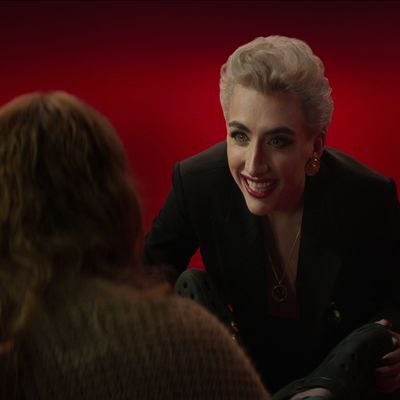
Now we’re cookin’ with gas! Sandman the comic series always went back and forth between long, seralized arcs and unique, stand-alone issues. The Doll’s House is the first big serialized arc, and it makes for much more satisfying Netflix-style TV than the previous stories.
Like HBO or the CW before it, Netflix has developed its own house style, for better or worse. Individual episodes don’t matter. In fact, the boundaries between episodes are intentionally blurred to keep you bingeing. If your episode doesn’t end in a cliffhanger, Netflix will most likely make you insert a cliff, then make you hang off it. The things that work best in comics — a contained story, a unique style, vivid colors and textures — all go against the Netflix style. No matter how prestige-y, streamers are ultimately in the business of making content to fold laundry to. That means a sense of endless narrative and a stylistic sameness that tends to replace color with shadow. But now form (Netflix) and content (Sandman) have come together. We’re juggling multiple story lines and endlessly teasing the twists to come.
This episode introduces us to Desire’s twin, Despair. They are often in competition with older brother Dream, in part because their realms kind of overlap. The realms of dreams, nightmares, stories, and delusions all use desire and despair as an engine to dream. Meanwhile, as Dream pointed out in Hell, you can’t despair unless you can dream of what you desire. These kids need a family therapist, but they’ll have to settle for trying to kill each other. Desire cops to being behind Nada and Roderick Burgess and tells Despair they’ve got a new thing cooking up: There’s a Dream Vortex. What’s a Dream Vortex? Unclear, but we do know it’s dangerous, that Rose Walker is one, and that the three runaway dreams (Gault, the Corinthian, and Fiddler’s Green) will be drawn to her.
Remember when I said to remember Rose back in episode five? Well, she’s back. Judy’s friend Rose is going through it. Her mother died, her buddy died in some mass-suicide event at a diner, then she found out she has a long-lost great-grandmother. It’s Unity Kinkaid, who is somehow still alive despite falling into a coma in 1916. Unity says she lived a rich, full life while being asleep for over 100 years, including marrying a man with golden eyes and having a baby. Well, the baby thing happened in the waking world, too. That baby had a baby, who had Rose’s mother, who had Rose and her brother, Jed. When their parents got divorced, Rose and Jed were separated, Parent Trap–style, which is cruel beyond belief when you think about it. Poor Lindsay Lohan(s).
Ever since Rose’s mom died, she has been on a quest to find Jed, and now that she’s a sugar heiress, she finally has the means to do it. Rose and her friend–surrogate mom, Lyta Hall, travel to Florida to try to find Jed. They move into a kooky B&B operated by drag queen Hal/Dolly (John Cameron Mitchell). Also living at the house are Ken and Barbie, Chantal and Zelda, and Gilbert. As played by Stephen Fry, Gilbert is a hoot and a half. His character is modeled on G.K. Chesterton, the author of the Father Brown mysteries and a classic dude in English oddball history. The gang feels like a big found family, but Rose should be more wary. After all, the Fates told her to beware of houses.
Yeah, everyone wants to meet the new Dream Vortex. The Fates show up and say some cryptic stuff to her, she somehow finds her way into Dream’s castle, and the Corinthian is looking for her. Luckily for Rose (and even luckier for her housesitter, Carl), the Corinthian is busy getting headhunted for a serial-killer convention. Three so-called “collectors” are organizing a meetup of like-minded individuals, and they’ve lost their keynote speaker. They decide to try for the Corinthian, who basically invented serial killing when he escaped the Dreaming in the 1910s.
In order to get his attention, they commit a few copycat murders. It’s a dangerous gambit, as collectors apparently hate copycats for taking credit for their hard-earned M.O. But once the Corinthian is told he’s an inspiration to their kind, his innate self-centeredness takes over. The Corinthian’s whole deal is that he thinks he’s deserving of more prestige and glory than he is given as just one of many nightmares. He wants to be the nightmare.
Unfortunately for him, a serial killer just doesn’t have the oomph he did in 1990. You kill one guy, in private? I’m shaking. When Gaiman first wrote this character, we were just beginning the true-crime industrial complex. Serial-killer culture was still taboo. Today, every single serial killer has a docuseries, and the real fear is random mass shooters, not a one-on-one death. Everyone thinks they can escape a serial killer; no one knows how to escape being in public.
But let’s move away from depressing social commentary and back to the episode at hand, which really chugs along. There’s a great balance between each story, and we get some face time with pretty much every new character. Lyta has her dream convo with her dead husband, and we get a peek at the inner workings of the Dreaming with Lucienne and Mervyn Pumpkinhead (Mark Hamill). We are immediately charmed by gossip queen Hal, and we feel for poor Jed.
Like all the most Netflix-y of Netflix shows, this episode ends with a character in dire straits. Jed has been lost in the child-services shuffle. His caseworker won’t divulge his location to Rose, despite her being old enough to become his legal guardian. She decides Rose isn’t as capable of being a parent as the married white couple Jed has been placed with. Turns out this couple is abusive, and as we close the episode, he is forced into the trunk of a car as punishment. Not cool, Florida Department of Children and Families!
Fables and Reflections
• I did the math: Unity is 118 years old. Presumably being connected to the Endless via Rose made her unnaturally long-lived? Seemed to work for Alex Burgess and his boyfriend. Also, how did a Black British family come to own a sugar empire in the 1910s? Bet there’s a story there. As discussed by Hob Gadling, the sugar trade historically had a very different connection to race.
• The kids playing Jed over the years are too cute, and I am very upset that they are suffering. This is also a very real problem in CPS agencies across the U.S. Black families are far more likely to be separated than white ones, owing to the systemic racial bias of CPS. People got so weird about the diversifying of Sandman, but making the Kinkaid-Walker family Black has already added so much nuance and real-world connection to the story.
• Since he’s a Star Wars nerd from way back, how frustrating must it be for Patton Oswalt to share a scene with Luke Skywalker only for them both to be there in VO form?
• Ken’s little topknot (too short to be a man bun) absolutely sent me. What a caricature of basic masculinity.
• As a kid who grew up watching Jeeves & Wooster on PBS, I take Stephen Fry using big words at me as an aural security blanket. Can’t wait for more Gilbert content. I’m editing fancams with his sword cane as we speak.


